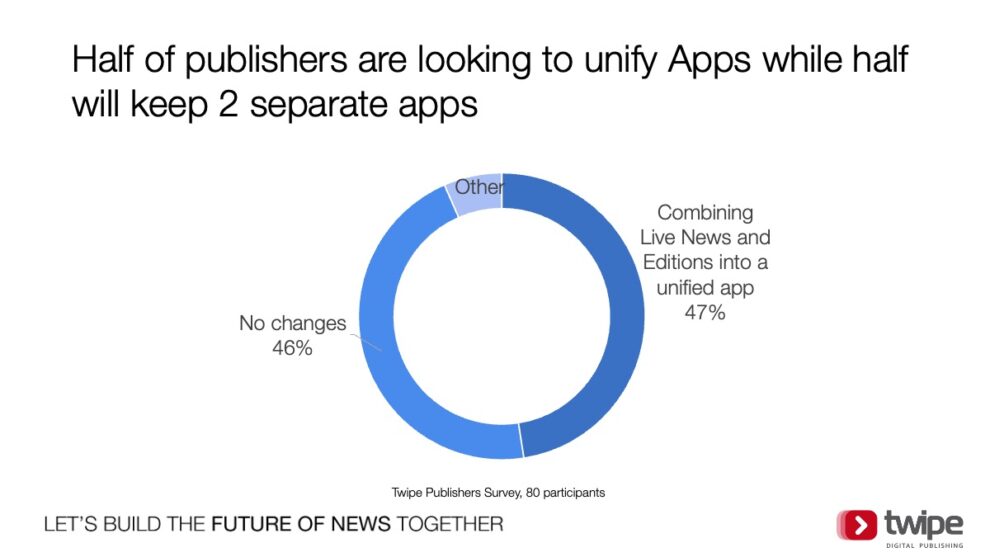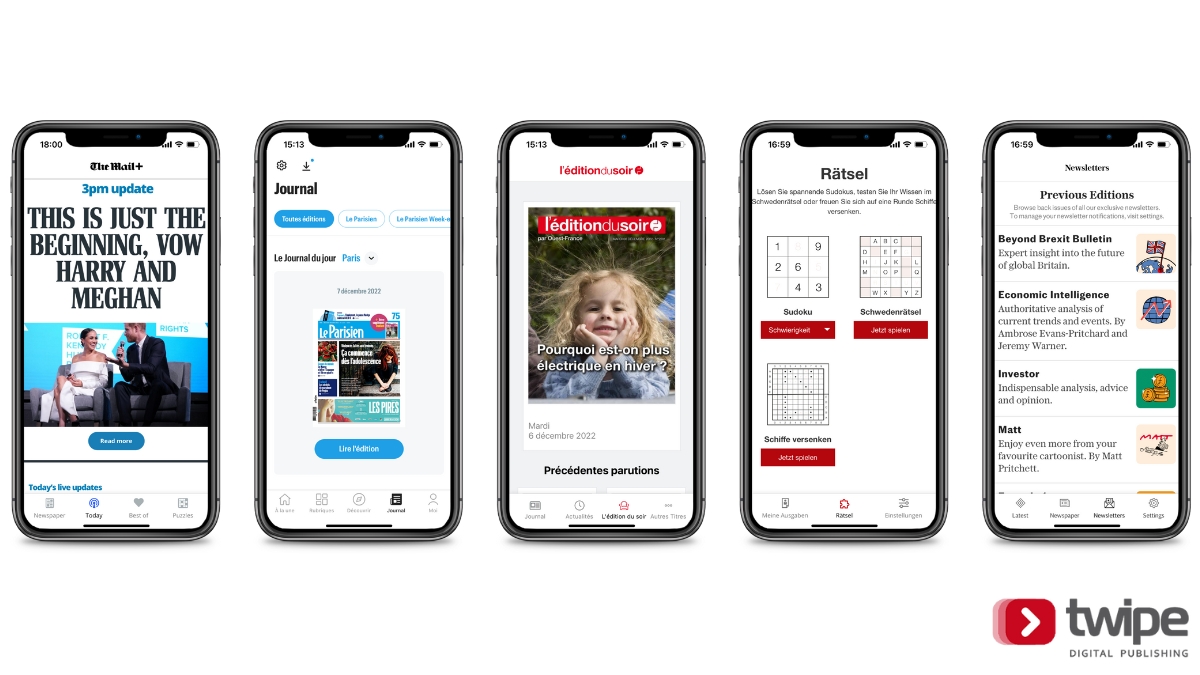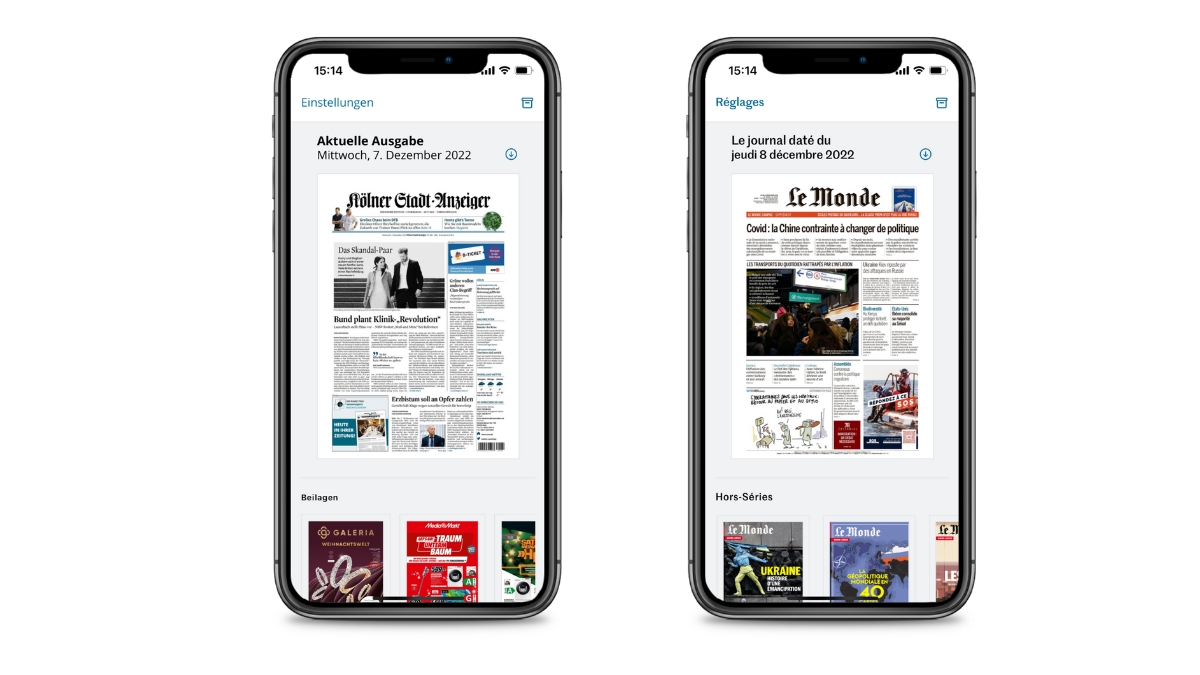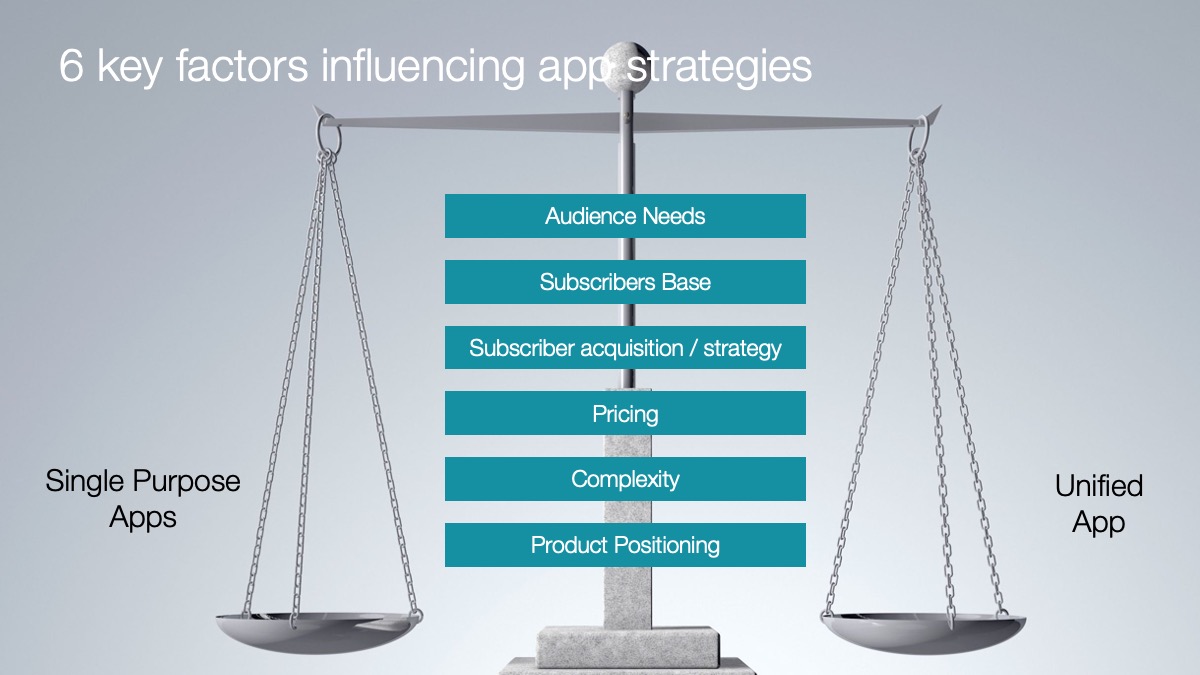How have news apps developed in 2022?
Earlier this year we discussed app strategy in a webinar with experts from The Telegraph, Schibsted and Frankfurter Allgemeine Zeitung. Over the course of 2022, we have monitored app developments closely to see how publishers have developed their strategies.
Unification of apps continues to be a growing trend
In an app strategy survey, 48% of publishers told us they planned to unify their apps. This year, several publishers followed this trend.

Ouest-France launched their new unified app to become a reader’s partner in life. The app features modules to guide daily consumption. Readers start their day with a push notification for the day’s ePaper. They then keep up to date with a live news module and later read their popular evening digital-edition “l’édition du soir”. Readers need just 1 app for their daily news consumption from Ouest-France. With a 4.5 star rating on the App Store, the app has been well received.
The Daily Mail launched the reinvented Mail+, providing edition readers with access to new features. The app’s Today module features edition based live news updates from throughout the day as well as a live news feed. The Best Of curated tab provides readers with suggestions from the Mail’s editorial team. The puzzles module lets readers complete their puzzle in app. The new app is used to bring readers to digital and is will liked by readers, with an impressive 4.7 rating on the App Store.
In May, The Independent unified their apps in a bid to achieve 4 million registered users. The app features the Daily Edition and Independent Premium. It also offers audio articles, live news, Independent TV and a “top 5” article list. The new app is open to non-subscribers, but the team can change the amount of paywalled content. According to Press Gazette, the app saw a 450% increase in weekly installations compared with its predecessors in its first week.
Other publishers have also unified their apps. Le Parisien brought their ePaper into their existing news app, whilst unified app pioneers The Telegraph updated their app to introduce more content with a newsletter hub.

A move to unified apps simplifies user experiences and reduces friction, could it be the best way to become a partner in life for subscribers?
Development goes on with separate apps
46% answered that they did not plan to unify or change their apps, and several publishers have continued to see success keeping their live news and edition app separate. This year, Le Monde updated both their editions app to have a new, stunning user experience. They also introduced an audio feature to their finite “La Matinale” app.
Kölner Stadt-Anzeiger chose to relaunch their existing editions app. In doing this, the publisher added an audio player for each article and a new app styling to give readers a refreshed and new feel and options. The German publisher also simplified their region selection so that readers can easier access content from other areas.

Keeping apps separated is a conscious choice of publishers to not overwhelm their readers. Different readers have different profiles. Some may want to consume edition content whilst others may want to consume news throughout the day. By keeping apps separated, publishers can allow readers to have the freedom of choice.
Digital editions spring up as lite news alternatives
2022 marked the launch of new digital editions. The most notable saw publishers launch finite products, separate to the daily news edition and live news products.
The Financial Times undertook arguably one of their biggest innovations in recent years with the launch of FT Edit in March. Publishing 8 articles a day, FT Edit is aimed at widening the funnel and converting people from its 26 million strong social media following. The aim is reflected in the pricing of the app. The app is free for the first month, 99p per month for the next 6 months and then £4.99 per month. The app is curated by a specific FT Edit editorial team. They aim to expose readers to the breadth of the FT’s content. An interesting twist towards the end of the year has seen the FT invite guests editors for the app including entrepreneur Steven Bartlett.

The Economist reinvented and relaunched Economist Espresso in early 2022 to provide readers with a daily briefing of 5 articles updated 3 times a day. Espresso has helped to boost engagement with existing Economist subscribers. Around 200,000 of The Economist’s 1.2 million subscribers using Espresso weekly. This number includes Espresso-only subscribers and is expected to grow as The Economist’s daily digital news team for the website and Espresso has doubled in size since 2021.
Both launches from financial focused outlets represent a move to open content to new reader personalities. The success of the products in terms of conversion will be one to watch in 2022 reporting figures.
Elsewhere in the digital edition world, Advance Local and Alabama Media Group launched new editions of the digital-only edition The Lede across other Alabama markets. The group also recently announced that they were stopping print because of their digital success.
Niche and non-news apps have continued success
In our webinar, we heard how Schibsted released weight loss app Vektklubb. The app has driven more traffic and subscribers to their news apps as they follow a personalised methodology to lose weight. Other publishers have seen success with niche and non-news apps across 2022.
In Q3, The New York Times announced that news alone is no longer the driver of subscription growth. The publisher has expanded its app offering with puzzles and cooking apps as well as acquiring The Athletic. As a result, The New York Times have strongly pushed subscribers towards their bundle products, encompassing all the publisher’s verticals. The publisher is on a mission to become the go-to place for all their subscribers’ information needs by reclaiming the utility which publishers used to own.
Following its release, Dutch publisher NRC saw growing success with their NRC Audio app. With around 300,000 weekly listeners and 800,000 weekly downloads, the publisher chose to add a paywall in late 2022. Whilst early episodes of some podcasts are available to listen to free of charge on platforms, NRC keep the majority of podcast episodes exclusively on their app. This aims to convert listeners into subscribers. Users in the app are confronted with a paywall advertised as audio to put audio forward as the dominant medium. There is no option for subscribers to go for a purely audio bundle. This is to get subscribers to interact with all NRC content. The move represents an early adoption of an audio paywall but is a result of success away from a traditional news app. Numbers are yet to be revealed but we look forward to seeing some figures soon.

Apps continue to be central to news publishers’ success and their importance is only growing in the digital world. If you’re interested in reinventing your app strategy, get in touch with our team.
Bonus: A poem on News Apps from ChatGPT
Jumping onboard the ChatGPT hype, we decided to ask the bot to write us a poem about news apps. We hope you enjoy.
The news app on my phone
Brings the world to me
In a compact, easy-to-use package
With just a swipe and a tap
I can access the latest headlines
And stay up-to-date on current events
From politics to sports to entertainment
The news app has it all
Delivering stories from near and far
It’s my go-to source for information
And keeps me informed and engaged
Thank you, news app, for being there
In this age of constant connectedness
You make it easy to stay in the know
And for that, I am grateful.
Other Blog Posts

Stay on top of the game
Join our community of industry leaders. Get insights, best practices, case studies, and access to our events.
"(Required)" indicates required fields

